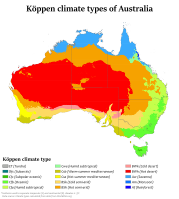
Photo from wikipedia
Background: As the global climate changes, the number of cases of hand-foot-and-mouth disease (HFMD) is increasing year by year. This study comprehensively considers the association of time and space by… Click to show full abstract
Background: As the global climate changes, the number of cases of hand-foot-and-mouth disease (HFMD) is increasing year by year. This study comprehensively considers the association of time and space by analyzing the temporal and spatial distribution changes of HFMD in the Ili River Valley in terms of what climate factors could affect HFMD and in what way. Methods: HFMD cases were obtained from the National Public Health Science Data Center from 2013 to 2018. Monthly climate data, including average temperature (MAT), average relative humidity (MARH), average wind speed (MAWS), cumulative precipitation (MCP), and average air pressure (MAAP), were obtained from the National Meteorological Information Center. The temporal and spatial distribution characteristics of HFMD from 2013 to 2018 were obtained using kernel density estimation (KDE) and spatiotemporal scan statistics. A regression model of the incidence of HFMD and climate factors was established based on a geographically and temporally weighted regression (GTWR) model and a generalized additive model (GAM). Results: The KDE results show that the highest density was from north to south of the central region, gradually spreading to the whole region throughout the study period. Spatiotemporal cluster analysis revealed that clusters were distributed along the Ili and Gongnaisi river basins. The fitted curves of MAT and MARH were an inverted V-shape from February to August, and the fitted curves of MAAP and MAWS showed a U-shaped change and negative correlation from February to May. Among the individual climate factors, MCP coefficient values varied the most while MAWS values varied less from place to place. There was a partial similarity in the spatial distribution of coefficients for MARH and MAT, as evidenced by a significant degree of fit performance in the whole region. MCP showed a significant positive correlation in the range of 15–35 mm, and MAAP showed a positive correlation in the range of 925–945 hPa. HFMD incidence increased with MAT in the range of 15–23 °C, and the effective value of MAWS was in the range of 1.3–1.7 m/s, which was positively correlated with incidences of HFMD. Conclusions: HFMD incidence and climate factors were found to be spatiotemporally associated, and climate factors are mostly non-linearly associated with HFMD incidence.
Journal Title: International Journal of Environmental Research and Public Health
Year Published: 2021
Link to full text (if available)
Share on Social Media: Sign Up to like & get
recommendations!